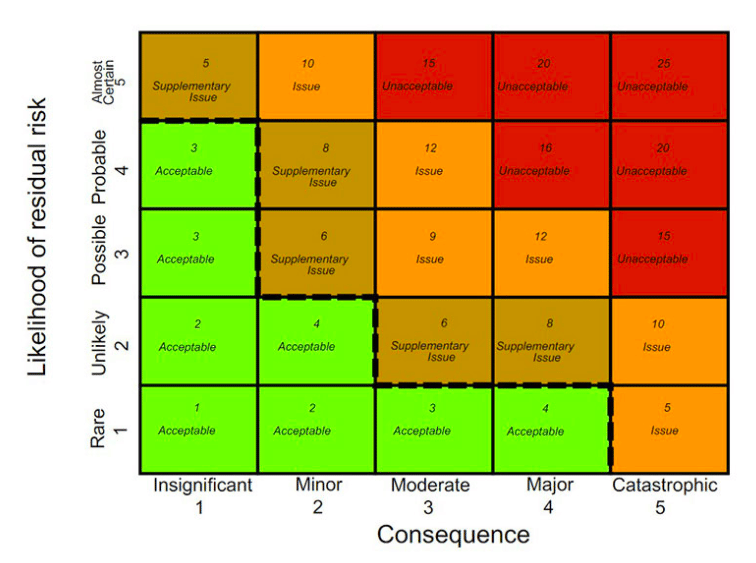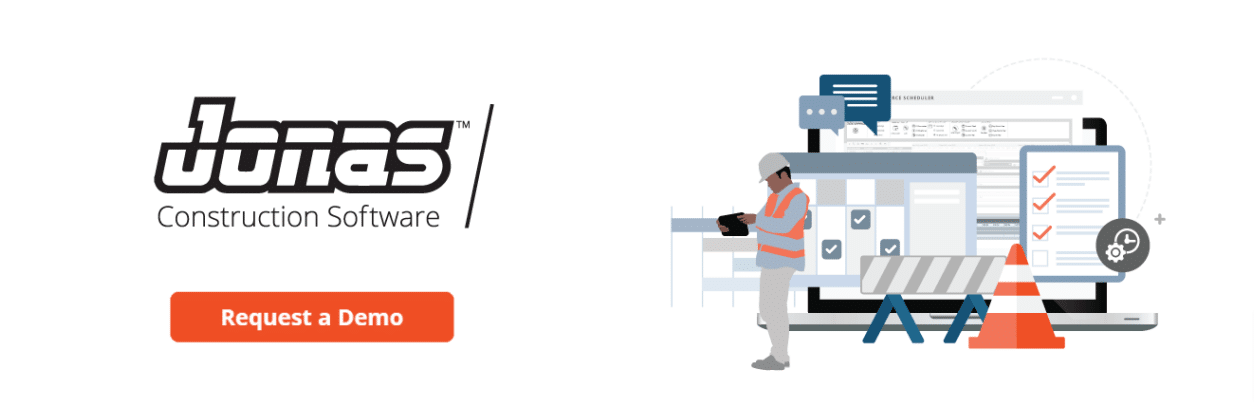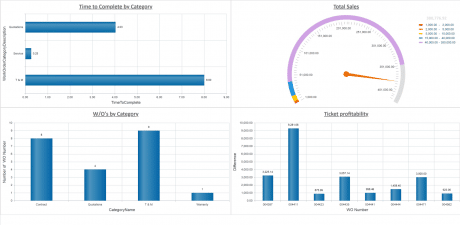Last Updated on July 17, 2023

Effective risk management poses a particular challenge for construction companies. On one hand, various risk factors have to be considered before, during, and after the construction project. Construction places new demands on the contractor every time. While it seems impossible to create an exact risk or cost forecast, you can decentralize risk management with a construction risk management plan.
In this article, you will learn about the seven key elements of an effective risk plan. You will also discover what benefits your business can derive from a carefully constructed risk management plan.
Qualitative Elements of a Construction Risk Management Plan
There are two proven methodologies in risk analysis: qualitative and quantitative. The main difference between these methods is that quantitative analysis explores the quantities that can be measured in numbers. Qualitative analysis is descriptive and deals with factors that can be observed but not measured. Let’s take a deeper look at this method.
Qualitative risk analysis is done on all risks and for all projects. It measures both the possibility of a specific risk event happening during the project life cycle and the impact it will have on the overall schedule if it happens.
In general, qualitative risk analysis is more subjective. The benefit is that it allows you to estimate the probability and prioritize risk in an easily digestible way to present it to stakeholders. Another benefit is that it can be used to manage risk at any stage of the project.
Risk Identification: What risks does your construction project pose?
In a nutshell, the risk management process is a sequence of steps that identify the risks for the successful completion of a project. Construction projects can pose many internal and external risks that may include:
- Financial risks: Fluctuating material costs, incorrect estimation, payment delays, or financial inexperience of the contractor are just some of the financial risks in a project.
- Environmental risks: These include severe weather conditions, natural disasters such as earthquakes, pollution, and seasonal implications.
- Technical risks: These include incomplete design, inadequate site investigation, unavailability of materials, design errors, or changes in project scope or requirements.
One of the best ways to control risks is to understand the different types and take steps to best avoid these risks. Sadly, there is no way to entirely avoid risks since unknown factors will always emerge throughout a project. However, if you can recognize and classify risks before you begin a project, you can elevate your risk management and avoid potential losses.
Risk Assessment: What are the probability and severity of your risks?
When planning your construction project, you should spend some time creating a risk assessment matrix, a tool that was designed to analyze risk. By doing so, your construction organization can detect and prioritize various risks by estimating the probability of occurrence. A risk matrix is also known as Probability Matrix or Impact Matrix.
One of the questions that you should start with is, “What could go wrong?” Think about potential risks to avoid these events from happening, then follow these steps:
- Recognize hazards: Think about all potential risks that could have a negative impact on your construction project.
- Analyze the risks: Once you identified the right risks, the next step is to carefully evaluate them.
- Evaluate the severity of the risk: Describe the possible damage or impact of risks, then grade them on a scale:
1=none or slight
2=Minimal
3=Significant
4=Major
5=Catastrophic
- Evaluate the likelihood of the risk: Assess the probability of certain risks occurring during your project lifecycle and grade them on the following scale:
1=Rare
2=Unlikely
3=Possible
4=Probable
5= Almost Certain

- Prioritize the risks: Compare varying levels of risk and create internal rules, procedures, or policies to prevent or deal with the risks. High impact, high probability risks should be managed first, while low-impact, low probability risks are less urgent.
The risk assessment matrix should not be set in stone. Instead, consider revisiting it regularly so that you notice and detect the new and emerging risks.
Risk Ownership: Who is responsible for managing each risk?

Once you’ve identified and ranked the risks, it’s time to set up the role of a risk owner. This would be the person or a team that ensures that the risk will be managed properly. The risk owner will oversee any steps to manage each identified risk. In the construction industry, both the project owner and the contractor make efforts to control risk. It’s important to assign a risk owner because this helps ensure that a risk response plan is developed, maintained, and quickly acted upon.
Risk Response Planning: How should people act if a risk occurs?
Now that you’ve ranked the risks and identified the risk owner, it’s time to plan how you will manage each risk. There are several risk response strategies, each coming with specific actions to implement each strategy. These strategies include:
- Risk avoidance: Even though the project team can never eliminate all risk events, some specific risks may be avoided. For example, you may reduce scope to avoid high-risk activities, increasing resources or time, or avoiding an unknown subcontractor.
- Risk transfer: Shift the consequence of a risk to a third party. Transferring the risk does not eliminate the risk itself. Risk transfer nearly always involves payment of a risk premium to the party taking on the risk, for example, insurance, performance bonds, warranties, and guarantees.
- Mitigation: Reduce the probability or consequences of an adverse risk event to a satisfactory threshold. Taking early action is more effective than trying to repair the consequences. A risk mitigation strategy could include using less complex processes, conducting more seismic or engineering tests, or choosing a more stable supplier.
- Risk acceptance: Your project team may decide not to change the project plan and deal with a risk or is unable to identify any other suitable response strategy. In this case, a contingency plan is required in case a risk occurs.
The risk response plan, also known as the risk register, should be written in every detail of actions that will be taken.
Risk Monitoring: How will you monitor risks throughout your project?
By nature, risks arise from uncertainties and are beyond anyone’s control. The best thing a project manager can do is to identify, analyze, and monitor risks. As environments, stakeholders, and even requirements change, the nature of risks and planned responses should change, too. Risk monitoring involves:
- Looking for identified and new risks.
- Taking quick corrective action when a risk materializes.
- Planning preventive actions when you identify a trend of a new risk.
- Measuring the effectiveness of risk responses.
Here’s how to approach these risk monitoring tasks:
Continuously reassess project risks: As the project progresses, you find out that some of the risks are not relevant, or the probability or priorities of few risks can change. , and new risks are identified. This reassessment is usually done regularly as a team exercise while keeping stakeholders in the loop, and the results are added to the risk register.
Outside audit for risks: A team outside of the project team should examine how effectively risks have been managed, including the way root causes are analyzed, and corrective or preventive actions are taken.
Analyze risk trends: By looking at project performance over a period of time, you can study the trends of costs, project schedules, and scope changes, and then try to forecast if there is a risk of any derailment in the near future. If the trend shows that any of the risks can materialize, then plan and put in place the preventive actions.
Reserve budget: Use this reserve only when certain risks materialize and you need to deal with them. As the project progresses, a project manager needs to keep an eye on the cost reserves and schedule buffers, if needed.
Meetings are an important part of this process. Regular meetings ensure that all project team members are aware of what risks may come up, and so they will be equipped to look out for symptoms and come up with good risk responses.
Quantitative Elements of a Construction Risk Management Plan
Once the qualitative risk assessment has been done and recorded, it’s time to assign a numerical value to each of the risks. During quantitative risk management, the impact of risk on the project is converted into numerical terms. This information is used to determine the cost and time contingencies of the construction project.
Quantitative risk analysis is objective. For example, it can be calculated that risk A has a 60% chance of occurring, based on quantifiable data such as fluctuations in resource costs, average activity completion time, logistics, and more. As a result, risk A has a 15% chance of causing a delay of X number of days. The outcome depends upon the quantity and accuracy of your data.
High-risk industries such as mining, oil and gas, and construction rely heavily on quantitative risk analysis. In fact, it’s a legal requirement. For the best results, qualitative and quantitative risk analysis should be conducted in tandem. This approach will provide you with the best possible insight into the risks and their possible impact on the successful outcome of your project.
Lionel Galway, in the Quantitative Risk Analysis for Project Management paper, discusses three risk elements that project management should consider:
- Schedule: Will the project be executed within the projected time frame?
- Cost: Will the project be completed within the budget?
- Performance: Will the project output satisfy the business and technical goals?
When these risks are quantified, the project team can develop effective mitigation strategies or add proper contingencies to the project estimate.
Cost Risk Analysis: What cost contingencies should you allocate to a project?
Contingency, or the funds added to the base cost estimate to cover any uncertainty or risk exposure, forms the material side of risk management. By adding contingency into total project cost, the project management team can cover risk exposure which in turn builds trust, improves transparency and project performance. For example, contingency funding can be used to purchase additional materials, labor, equipment due to minor errors that occur when the estimate is put together. Contingency can be calculated using:
- Deterministic methods, when the contingency is estimated as a calculated percentage of base cost depending on the project phase.
- Probabilistic methods, when uncertainties are displayed in the cost estimate using statistical distributions.
Most often, deterministic methods are the easiest and most popular methods for establishing the cost contingency reserve fund. It’s important to note that contingency funding is not intended to be a blank check to hide mistakes that occurred during the execution of the project.
Schedule Risk Analysis: What is an appropriate duration for your project?
A schedule risk analysis helps to evaluate the possible impact of uncertainty on the project duration and cost. During this analysis, a project manager identifies the risks to the project plan and proposes measures to mitigate these risks in order to achieve a better outcome.
No one looks into a crystal ball when making estimates about activity time and costs. Project managers often tend to be too optimistic or reserved, which can lead to estimation errors. That’s why it’s important to follow all four steps of schedule risk analysis:
- Baseline schedule: Create an activity timetable using one of the many techniques available (PERT, CPM, and more).
- Define risks: Using a basic understanding of probability and distribution functions, the project manager can estimate the effects of unexpected events on the project end result.
- Run Monte-Carlo simulations: Create several project progress simulations using Monte-Carlo simulation. This is a simple technique that involves a simulation engine to quickly generate multiple simulations which unveil a duration and cost for each project activity.
- Decrypt the results: As the result of a schedule risk analysis, you will come up with a set of measures ranging in criticality and sensitivity.
Certainty is a rare commodity in the uncertain world of construction and complex projects. The schedule risk analysis looks at the project activity durations with reasonable skepticism, trying to identify in advance the difficulties that may occur.
Project risk management is a challenging process that requires plenty of qualified resources and tools. One such tool is a construction risk management plan.
Benefits of Construction Risk Management Plans

Merging both quantitative and qualitative elements of a construction risk management analysis, a risk management plan helps a business clearly define the risks, reduce their likelihood, and provide a system for better decision-making that helps avoid future risk. We’ve broken it down into the four most important reasons why risk management plans are essential for successful project completion. This makes the document a valuable effort for every construction organization.
Greater Operational Consistency & Efficiency
Construction businesses that have risk management plans can be combat-ready financially when a problem arises. When a company plans for the risks and responds to them quickly and competently, this saves time, money, physical resources while also allowing your employees to spend more time working on value-added tasks instead of constantly fire fighting. Team members gain the knowledge and workflows that enable them to make decisions and avoid risk, which in turn improves the efficiency of your construction business. Your people have the right tool it needs to meet the budget and achieve targeted goals. Without well-defined risk management strategies recorded in a plan, your projects become weaker and more exposed to problems.
Greater Confidence in Your Projects
Once you know your risks, the budget for dealing with them, and have a clear path to mitigating them, you grow confident in the success of your project. You also build yourself an invaluable tool for reporting risk to the senior management as well as the project sponsor and team.
Another benefit of a risk management plan is its reusability. Using a clearly defined risk management plan, you utilize many opportunities to capitalize on your organizations’ strengths. The risk management plan not only helps you evaluate your current project’s success but also helps you build best practices for the future.
Improved Safety
Risk management is all about identifying possible risks, problems, or disasters before they hit your project really hard. That’s why a risk management plan is indispensable. Not only it builds trust in your project but also ensures a safe and secure environment for your employees, visitors, and customers. Among other benefits, a good risk management plan:
- Reduces legal liability and threat of litigation
- Decreases the number of injuries, hazards, and risks in the workplace
When you invest time and effort to build a solid risk management plan, you mitigate the risk of spending thousands of dollars in legal and internal costs.
Increased Profits
All construction businesses face the risk of unanticipated events, such as a natural disaster, loss of funds through theft, or injury to employees or visitors. Any of these events can cost your company money or even cause your business to close.
With a detailed and comprehensive risk management plan, you can plan for the unexpected which in turn minimizes extra costs before they happen. However, a well-constructed risk management plan contributes to higher profits in several other ways:
- A thorough risk assessment reduces the likelihood of workplace accidents as you identify areas to improve work processes or training.
- Risk assessments reduce and prevent fines, lawsuits, and penalties from costly non-compliance issues.
- Your people are a valuable business resource. By having a solid risk management plan in place, you show employees that your business cares about their safety which in turn boosts morale.
While a risk management plan increases the financial stability of your operations, it has yet another benefit. While working on your plan, you can define your insurance needs to save on excessive premiums. Insurance companies may view your organization more favorably if you can prove you have a stable risk management plan which can help reduce the impact of potential claims.
Of course, no risk management plan can ensure your business is completely “disaster-proof,” a good plan can definitely increase your chances of long-term profitability.
Risk assessments need more time, energy, and resources when implemented for the first time. The very first risk management plan you create will be the most resource-intensive since you need to revise your entire work process. Time after time, the process becomes more efficient and improved.
The Project Management Institute (PMI) shares these best practices in risk management:
- Keep it simple
- Identify the risks aligned with development process objectives
- Develop the Project Risk Management procedure from the very beginning
- Organize the project team with clear responsibilities assignments
- Constantly update the list of risks along the development process
- Maximize the project team participation in risk identification and control strategy definition
- Use the result of the risk management process to feed others project management processes
- Keep a proactive attitude towards risk
Risk management plans are an effective method that can save you money, reduce the risk of a workplace injury, and protect your finances and other business resources. Thankfully, there are ways to take the pressure off creating and maintaining such plans.
Mitigate Your Construction Project Risks with Jonas
How many times have you heard about a business that failed due to “unforeseen circumstances?” With Jonas Construction Software, you can take a holistic approach to risk management and risk reduction by leveraging all the data you need to perform an effective risk analysis from a single platform. Thanks to fully integrated construction and service management, you have everything you need to remain compliant, reduce risks and drive efficiencies. Regardless of the scope or complexity of your project, you have everything you need to make the best decisions for your construction business.







